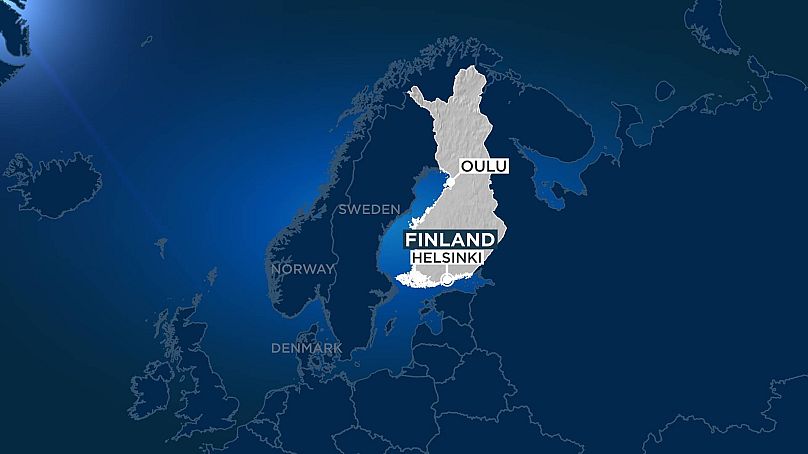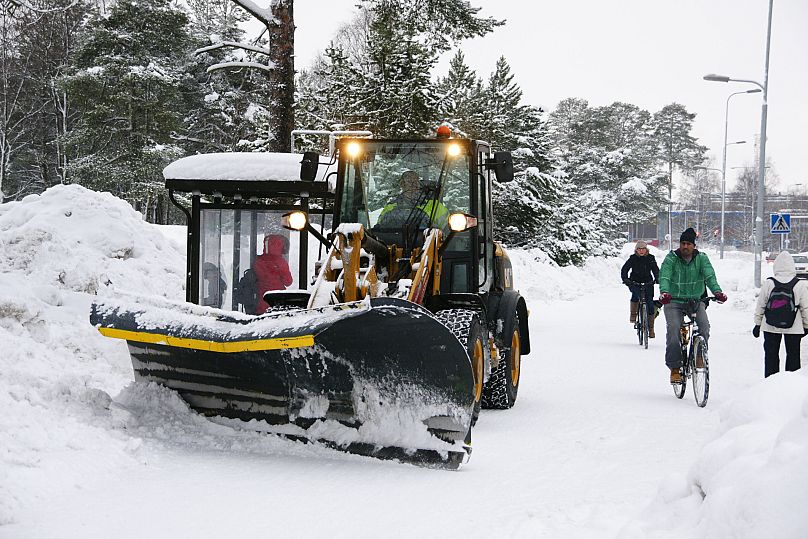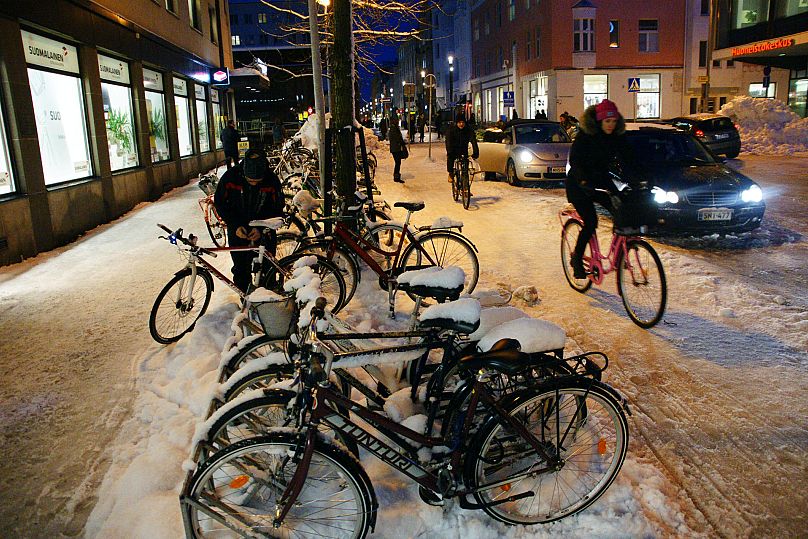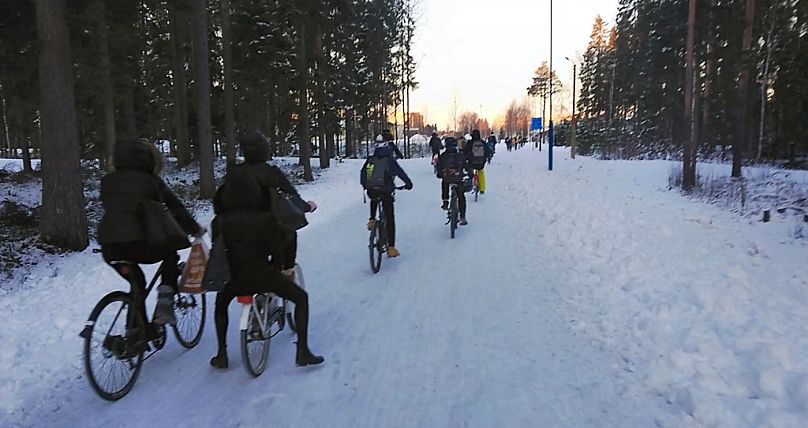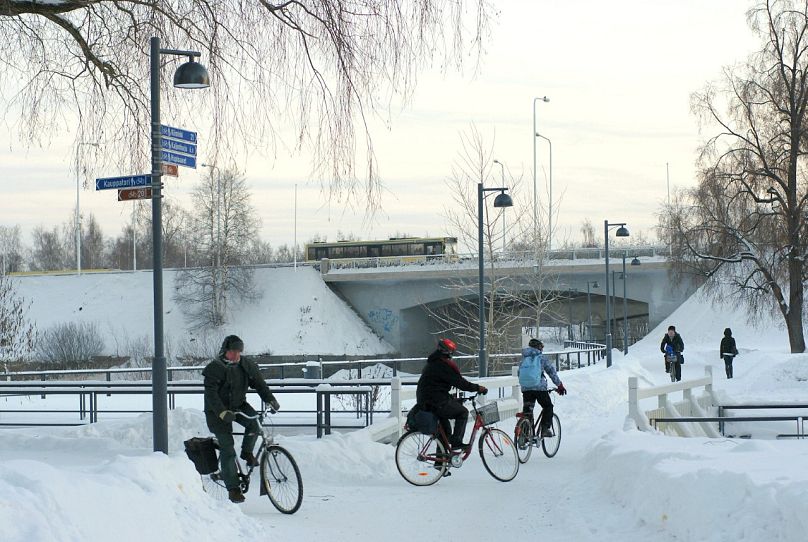Despite the long, dark, and snow-filled winters, locals keep pedalling their way to and from work and school.
In a city blanketed by snow for five months each year, you wouldn't blame cyclists for putting their bikes into hibernation during the winter.
But the people of Oulu, Finland, are made of stronger stuff.
Despite the long, dark, and snow-filled winters, locals keep pedalling their way to and from work and school.
Around one-in-five of all trips made in Oulu are by bike, a figure that falls to 12% in the winter. By comparison, in London, around 2% of all trips are made by bicycle. In the Dutch cities of Utrecht and Amsterdam half of all journeys are on a bike, against a third in Copenhagen. Further south in the capital Helsinki cycling, on average, represents 9% of trips.
“The colder the weather, the more beautiful nature gets,” said urban wellbeing engineer Timo Perälä, who is one of Oulu’s many year-round cyclists.
“Today I cycled over the frozen sea ice of Oulu Bay on my way home, and it was breathtaking. Those are the kinds of experiences you get by bike in wintertime.”
Perälä is not alone on the city’s bike paths. More than half of all trips to universities and schools over the year are made by bike.
Even on very cold winter days, hundreds of unlocked bikes stand in the snow outside of Oulu’s schools as a testimony to their popularity.
Why does winter fail to deter cyclists in Oulu?
One of the key reasons is the city prioritises cycle infrastructure and maintenance during the winter months.
“You can trust that all the main cycle paths will be ploughed before the morning commute,” said Otto Simola, chairman of Oulu’s cycle association.
His family doesn’t own a car, so most of their trips around Oulu’s 3,817-square-kilometre area — 22% of which is water — are by bike or on foot.
“Ploughing snow from the cycling paths is prioritised higher than ploughing of the roadway,” said Harri Vaarala, a traffic engineer at the City of Oulu.
This, said transport psychology researcher Angela Francke from the University of Dresden, sends an important message to cyclists.
“It shows that they are valued,” she argued.
Although different local and regional authorities have responsibility for various Oulu cycle paths, one subcontractor has been hired to plough the main regional cycle routes. As a consequence, each one is dealt with from the beginning to end in one go.
Also, the drivers of the service vehicles are obliged to cycle on the routes themselves, which, according to Vaarala, has improved the quality of their work considerably.
Meanwhile, a digital map shows the condition of routes for pedestrians, cars and bicycles in real-time. Commuters, called cycling agents, report back on how well the paths are maintained in the winter, and if the ploughing has been done well, the subcontractor is awarded a bonus.
Why Oulu's snow is easier than the weather in other European cities
While cycling in temperatures that can plummet below -30℃ might seem extreme, Oulu’s subarctic climate makes for better conditions than the slush, mud, and rain that many other Europeans have to deal with during winter, said Vaarala.
“Sure, it is easier here than in the south," he said. "-15℃ is much better to cycle in than sleet.”
From November to the beginning of April, temperatures usually stay below freezing, with average temperatures in January and February below -10℃.
“This makes for pretty good circumstances,” Vaarala noted, adding that salt is not used on Oulu's streets. Instead, ploughs only clear away the uppermost layer of snow.
“The thin layer of remaining snow on the ground gets packed when people cycle on it, and thanks to the snow, you will get a quite good grip.”
Simola, who cycles daily, agreed, saying that pedalling on the snow can be even more comfortable than on the bare asphalt.
“It is smooth to ride when the potholes are filled with snow," he said. "The snowploughs often clear a bigger area than the actual bike road, so cyclists will get an even broader path to ride on.”
The compressed snow is not slippery and that is why more than two-thirds of Oulu’s cyclists opt to not use studded tyres. In general, no special gear is needed when cycling through the wintery Nordic landscape, according to Pekka Tahkola, an urban wellbeing engineer at Oulu firm Navico.
“You can use whatever piece-of-shit-bike you have, and just wear the same clothes as you otherwise would in the cold,” he said. “If you like special gear, feel free to use it. It doesn’t really matter, as long as you go out and you are physically active. The environment, the city and your health will thank you.”
Oulu's winter cyclists are an 'inspiration'
Although the weather conditions and climate in northern Finland are different from most other European cities, there is still plenty to learn from Oulu, said Jill Warren, CEO of the European Cyclists’ Federation.
“Seeing people cycling in the snow is inspiring," she said. "This reminds us that it makes sense to invest in infrastructure also in adverse weather conditions.”
Visitors used to often come to Oulu to learn about year-round cycling best practices.
But the COVID-19 pandemic has dampened visits from abroad, so now Timo Perälä and Pekka Tahkola are developing a virtual reality tour around the city.
Perälä and Tahkola are the driving force behind the promotion of Oulu as a year-round cycling-friendly city to the world.
In 2013, they founded the Winter Cycling Federation and held the first-ever Winter Cycling Congress in Oulu. The congress has since been hosted by different cities in Canada, the Netherlands, the United States, Russia, and again in Joensuu in Finland in 2020. The Winter Cycling Congress 2021 will be held online on February 11.
Among the participants at the first winter cycling congress in Oulu was Andrea Weninger, transport planner and CEO at Rosinak & Partner in Vienna.
In Vienna, 7% of trips are conducted by bicycle, and a third of the cyclists are all-season cyclists.
The municipality and cycling NGOs try to increase cycling during the winter by focusing on winter maintenance and setting up different campaigns.
Though Weninger found cycling in the cold inspiring, she didn’t think that Vienna with its warmer climate could put the experiences from Oulu into direct use. During its coldest month, January, the Austrian capital has an average temperature of about zero degrees.
Weninger did, however, take some important lessons with her.
“I learned that cold weather conditions can be normal, and that maintenance of all streets, and not only a few of them, is necessary.”
In Finland’s capital, Helsinki, about 650 kilometres south of Oulu, the city council recently approved an action plan to double the percentage of trips that are conducted by bike, from the current 9% to 20% by 2035. Increasing the modal share of cycling is an integrated part of the city’s goal to become carbon neutral by the same year.
Copenhagen functions as the main cycling role model of Helsinki, since the Danish capital's climate is more similar than Oulu’s freezing winters. Oulu does, however, make a great example, noted Helsinki’s cycling coordinator, traffic planner Oskari Kaupinmäki.
“Whenever people complain that ‘it’s too cold’, or ‘too windy’ to cycle, we can point to Oulu and say that ‘it’s not about the cold,” he said, adding that all of Europe’s most successful bike countries are found in the northern part of the continent in countries like Finland, Sweden, Denmark and the Netherlands.
Visionary traffic planners
With a cycling network consisting of more than 800 kilometres of segregated bicycle routes, Oulu’s infrastructure is built particularly with cyclists and pedestrians in mind.
This is the result of people-oriented city planning since the late 1960s when cars were the big deal worldwide, Tahkola’s colleague, Perälä, explained.
The city had actually ordered a US-style traffic plan from New York, complete with broad car lanes, ring roads, and complicated intersections.
However, visionary traffic planners decided to go in another direction, and the grand plan was scrapped.
Instead, pedestrians and cyclists were prioritised.
“In Oulu, the bikes get to take the most direct routes, while cars have to take detours, and this is unique in the world,” Perälä pointed out.
The inhabitants are used to this cycling and walking-centred way of planning, so promoting cycling stirs no controversy among Oulu’s car owners, both Vaarala, Perälä, and Tahkola assured.
In other European cities that are already planned for cars, following Oulu’s example might be difficult, but not impossible, Perälä argued: “It requires tough decisions and dismantling of some roadways.”
He pointed to Paris as an example of how strong leadership can transform the way a city is used. Here, mayor Anne Hidalgo has, according to the French capital’s street counters, managed to double the number of cyclists in a year (between 2018 and 2019), mainly by increasing the cycle lane network by hundreds of kilometres.
'Cycling throughout the year is a mindset'
When the share of bike trips in a city goes up, congestion eases, noise and emissions go down, and the inhabitants become healthier, said Vaarala. This will also lead to economic savings: a calculation from Helsinki showed that for every euro spent on cycling, the city would reap benefits worth €8.
With this in mind, it is easy to understand why many European cities are now actively promoting cycling as a mode of transportation for people of all ages and abilities - and through all seasons.
Some of the most well-known are Amsterdam and Copenhagen. Also, cities such as Vienna and Helsinki made it to the latest Copenhagenize Index of the world’s 20 most bicycle-friendly capitals and other cities with more than 600,000 inhabitants.
“It is desirable to make people bicycle all year round,” said Francke. “I am super positive that most cities want to create a bike culture. Cycling is just such a great mode of transportation; it’s independent, mobile, and cost-effective.”
Francke, whose main research interest is cycling, stresses that strong bike countries like the Netherlands and Denmark were not always great places for people on two wheels.
“If you make roads for cars, they will be filled, and if you make cycle lanes, they will be filled too! It all depends on what kind of city you want.”
When building a culture that sustains cycling all year round, “cities can take a shortcut by learning from positive role models such as Oulu,” said Francke, who experienced cycling in the snow in -15 degrees in Finland last year.
“As you can see in Oulu, cycling throughout the year is a mindset,” she stated.












